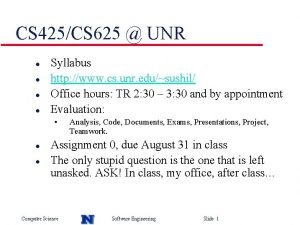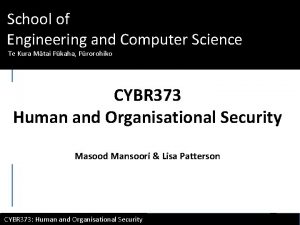School of Engineering and Computer Science Te Kura























- Slides: 23

School of Engineering and Computer Science Te Kura Mātai Pūkaha, Pūrorohiko Security Principles II CYBR 271 T 2 2020 Ian Welch, Harith Al-Sahaf Slides based upon these ones: https: //www. cs. montana. edu/courses/csci 476/topics/secure_coding_principles. pdf

Learning objectives - List the security principles of secure design and implementation: - Secure by design - Secure by default - Secure by implementation - Describe why each principle is important to security. - Identify the needed design principle. CYBR 271: Secure Programming Slide 2

Secure by design - Security principles Establish trust boundaries Don’t reinvent the wheel Economy of mechanism Separation of duty Open design Minimize the attack surface Secure the weakest link CYBR 271: Secure Programming Last lecture Slide 3

Secure by design - Security principles Establish trust boundaries Don’t reinvent the wheel Economy of mechanism Separation of duty Open design Minimize the attack surface Secure the weakest link CYBR 271: Secure Programming Slide 4

Open design Principle: The security of a component or system should not depend on the secrecy of the design or implementation – Kerckhoff's Principle: Crypto-systems should remain secure even when the attacker knows all the internal details (stated in 1883) Keys: the secret data that must be protected Also known as avoiding "Security by Obscurity" It is highly unlikely that any algorithm or method can be kept secret – Many people know – Attackers can guess and probe the application – Your own documentation may reveal the secrets CYBR 271: Secure Programming Slide 5

Open design Openness applies to algorithms and implementation details, but not to data like encryption keys and passwords (the Keys) The more review and testing of security code, the more secure it becomes (assuming some skill!) The security of a system should depend on the possession of easy to protect passwords and keys, not on the ignorance of the attacker CYBR 271: Secure Programming Slide 6

Open design You should not depend on obscurity for protection But using obscurity as camouflage is fine – Port knocking – Changing the name of the Admin user – Changing cgi-bin to demos – Changing the name of system administration executables But making it more difficult, is never the wrong thing to do CYBR 271: Secure Programming Slide 7

Open design Design security features as though only the keys are private –The point of open design is that secrets usually are not secret –If your software has proprietary algorithms, processes and procedures, assume they are public when you design –Without proprietary algorithms, you need to be especially careful with keys Areas where data is commonly assumed to be safe when it is not –Registry keys –Hard-coded passwords or encryption keys –Data or code in HTML pages –Anything stored on a client host –Anything sent over an unencrypted communication channel CYBR 271: Secure Programming Slide 8

Open design Obscure or customized security algorithms are seldom reliable which increases risk - Encryption - Randomization - Session management Any security mechanism that depends on no one noticing is doomed to failure Keys are safe only if you make them so – Inside of your Trust Boundaries – Security features designed to protect them even if everyone knows how they work CYBR 271: Secure Programming Slide 9

Secure by design - Establish trust boundaries Don’t reinvent the wheel Economy of mechanism Separation of duty Open design Minimize the attack surface Secure the weakest link CYBR 271: Secure Programming Slide 10

Minimize the attack surface Attack surface describes all the different points where an attacker could get into a system and where they can get data out. Smaller an attack surface the better. Allows comparison of relative vulnerability of different systems, for example a building, program or network. This Photo by Unknown Author is licensed under CC BYSA Compare effect of changes to a system after adding new features. Leads to a tendency for a system to become less secure over time. https: //www. wired. com/2017/03/hacker-lexicon-attack-surface/ CYBR 271: Secure Programming Slide 11

Attack surface - example Consider a place to wait out the Zombie apocalypse. Which of these has the smaller attack surface? Shopping mall CYBR 271: Secure Programming Tower house Slide 12

Attack surface - software The Attack Surface of an application is: 1. The sum of all paths for data/commands into and out of the application, and 2. The code that protects these paths (including resource connection and authentication, authorization, activity logging, data validation and encoding) 3. all valuable data used in the application, including secrets and keys, intellectual property, critical business data, personal data and PII, and 4. the code that protects these data (including encryption and checksums, access auditing, and data integrity and operational security controls). https: //cheatsheetseries. owasp. org/cheatsheets/Attack_Surface_Analysis_Cheat_Sheet. html CYBR 271: Secure Programming Slide 13

Secure by design - Establish trust boundaries Don’t reinvent the wheel Economy of mechanism Separation of duty Open design Minimize the attack surface Secure the weakest link CYBR 271: Secure Programming Slide 14

Secure the weakest link Principle: Attackers will attack the weakest security point in the application – Corollary: One valid secure coding outcome is encouraging the attacker to go after someone else – Corollary: A chain is as strong as its weakest link Adversaries will expend the least amount of effort possible to penetrate a system –They will work no harder than necessary –If they have to work too hard, they may move on to another target (depending on how attractive the asset is) CYBR 271: Secure Programming http: //www. businessearth. com/wp-content/uploads/supply_chain_sustainability. jpg Slide 15

Secure the weakest link Threat Models will lead you to the weakest areas –Invest in remediating weakest security defenses –There will always be a new weakest link –Attackers will go after weakest links simply because they are easy They are looking for a foothold or information to use Factor in the four sources of threats –Social: People –Operational: Processes (and People) –Technological: The application and network –Environmental: Facilities Which threat sources are more likely to be weak? CYBR 271: Secure Programming Slide 16

Secure the weakest link - example HP Printers using Jetdirect firmware include an embedded web server –Allows for remote administration of the device –Due to an undisclosed design flaw, the server handles passwords in an insecure manner –Attacker can gain unauthorized access to the device and also create a denial of service. Networked printers, in general, are poorly secured. Example of the Netgear routers with the vulnerable web server. CYBR 271: Secure Programming Slide 17

Secure the weakest link – tips Use Threat Models to understand your attack surface Make sure you don't ignore operational and social threats Test your application thoroughly –Have a test plan –Use Red Teaming and/or third-party audits –Test for all of the obvious vulnerabilities - SQL Injection - XSS - Authentication Bypass CYBR 271: Secure Programming Slide 18

Secure by default Secure by design was a set of principles that lead to less vulnerable systems. Secure by default is a set of principles with respect to configuration of the system that lead to less vulnerable systems. - Least privilege - Default deny - Fail securely CYBR 271: Secure Programming Slide 19

Secure by default - Least privilege - Default deny - Fail securely CYBR 271: Secure Programming Slide 20

Least privilege Principle: A subject should only be granted only the privileges needed for an operation Corollary: Privileges should be associated with the function being performed, not with the identity Least Privilege is a concept that means that at any given application state, the user will operate at the lowest level of access rights possible A program should be given only those privileges it needs in order to satisfy its requirements: - no more, no less - if a program doesn’t need an access right, it should not be granted that right - think of it as “need to know”rule - thus if the program is compromised, damage is limited CYBR 271: Secure Programming Slide 21

Least privilege - example Do you run your local desktop as an Administrator user? - You are not applying the Least Privilege Principle The damage from executing malicious code will be much greater than if you didn’t On Linux, running services as root or with setuid permission bit set has the same effect - Running the Apache web server as root That gives every executable that Apache runs root privileges on your system If a program runs as root, many of it's normal defects become security defects CYBR 271: Secure Programming Slide 22

Summary - Security principles Establish trust boundaries Don’t reinvent the wheel Economy of mechanism Separation of duty Open design Minimize the attack surface Secure the weakest link CYBR 271: Secure Programming - Least privilege - Default deny - Fail securely Slide 23
 Sistem peredaran darah ular
Sistem peredaran darah ular Erik jonsson school of engineering and computer science
Erik jonsson school of engineering and computer science Erik jonsson school of engineering and computer science
Erik jonsson school of engineering and computer science Erik jonsson school of engineering and computer science
Erik jonsson school of engineering and computer science Ucf software engineering
Ucf software engineering Computer science and engineering unr
Computer science and engineering unr Ucla
Ucla The fu foundation school
The fu foundation school What is system in software engineering
What is system in software engineering Klipsch school of electrical and computer engineering
Klipsch school of electrical and computer engineering My favorite subject is art
My favorite subject is art Computer science vs software engineering
Computer science vs software engineering Computer science software engineering
Computer science software engineering Computer science software engineering
Computer science software engineering Reverse engineering computer science
Reverse engineering computer science Oussep
Oussep śpiewające brzdące gdacze kura ko ko ko
śpiewające brzdące gdacze kura ko ko ko Kura dominant white cornish
Kura dominant white cornish Jak odróżnić gęś od gąsiora
Jak odróżnić gęś od gąsiora Młoda intensywnie tuczona kura
Młoda intensywnie tuczona kura Broncho vaxom kúra
Broncho vaxom kúra Teoryang humanismo halimbawa tula
Teoryang humanismo halimbawa tula Eşleştirmeli kura
Eşleştirmeli kura Eclipse kura
Eclipse kura










































